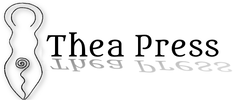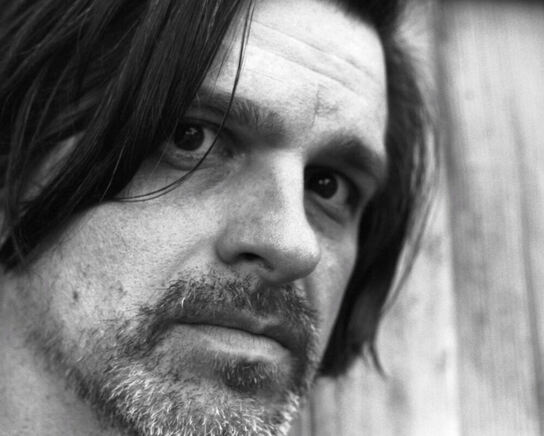In honor of Small Press Month, Thea Press interviewed Jason Bruner. Jason is co-author and photographer of Dreaming Along the Laurel.
What inspired you to start taking photos? When we moved to the metro-Phoenix area, our first daughter had just been born. The rhythm we developed with her (and continued with our other two children) was for me to put her in a baby carrier and go for long walks in the early morning. I hadn't been someone who spent much time walking through urban spaces before, and going at that pace helped me to pay attention to mundane details that are often blurred if you are using motorized transportation. And walking the same streets for several years then allowed me to see the subtle changes that come with the seasons, new residents, and migratory birds. While the impulse to get a decent camera stemmed from wanting to be able to take better pictures of our kids, it quickly became a way to think visually about my context and who I was in relation to it.
What does your photography process look like? That can vary, depending on what I want to accomplish. For street photography, where I might go to a part of the city I don't know well and take pictures of what's there without intervening, I find that the process needs to feel more like jazz: that you take what's there and make what you can on its own terms, joining in where it feels like it fits. On my more enjoyable days, this feels like I'm riding the flow of a stream, or just letting a melody carry me. If I'm photographing people, it's also important to be open and improvisational -- a photograph is evidence of a relationship and the question is what kind of relationship is it in that moment? If I plan on having a longer documentary presence, then I'll often not start with a camera, but with a conversation -- or multiple conversations -- because a camera can also create distance, a sense of performance, or intimidation -- and those are often things I want to either downplay or use intentionally, and that's hard to do without trust being established first. Still, most of the time, I view taking photographs in a similar way that I approached athletic events: a lot of the thought and effort are in the prep work, but in the actual moment (of either a race or of taking pictures), you want that prior thought and training to not be something you consciously think about, and trust that you are prepared enough to intuitively do what you need to do.
Of your various photos, what is one of your favorites? Why? I really like the one that is on the cover of Dreaming Along the Laurel. It feels like it captures the magically fuzzy boundaries of someone who's not quite grown up, and how that world is full of these pockets where you might get drawn into playful wonder.
What are your thoughts on the use of AI tools (e.g. ChatGPT) during the creative process? I've knowingly asked AI chatbots two questions on two separate occasions. I got a weird, sinking feeling in my stomach on both occasions and haven't touched it since. I generally feel that I would have been more comfortable with the world had I lived before the internet.
Tell us about one or more of your favorite photographers and how they've impacted you. There are so many. The way Teju Cole takes photos that feel like haikus, or storied moments. My friend, Amy Elizabeth, takes the most wonderfully creative self portraits. And I deeply admire Jim Mangan's ability to contextualize people within landscapes. Still, W. Eugene Smith is probably the photographer I continuously return to. He was an American pioneer of the mid-20th century photo essay, which he first developed in a beautiful series called "Country Doctor" for Life magazine in the late 1940s. He eventually moved to Pittsburgh to undertake a project that would be a visual portrait of the entirety of the life of a city, spending 3 years taking some 15,000 photos that he also developed and printed himself. He tried to publish a version of it, but considered it a failure, and never exhibited the collection. Thankfully, others have compiled larger collections from those photographs, and I hold these as a remarkable feat of skill, artistry, and extraordinary personal commitment.
What has photography taught you about the world and yourself? There is beauty -- capaciously defined -- all around us. There are things to draw your curiosity everywhere. It has been a tool for me to pay attention, and to be open to the world in a way that I'm not always inclined to be. Photography has made me pay attention to shape, color, proximity, and tiny details in a way that I deeply value, which can open up a string of delights. With a camera (and especially a film camera), I find that I'm more willing to talk to strangers who seem interesting but who I might shy away from otherwise. Those interactions have led to new friendships and meaningful exchanges. It's a tool to pursue curiosity in myself and with others, and there's no limit to where that leads.
What advice do you have for aspiring photographers? Don't pay attention to Instagram. Learn to use whatever equipment and gear you have (even if it's just a phone or a disposable film camera), rather than thinking fancy equipment will necessarily lead to better pictures. As often as you can, let those constraints push your creativity and your skill.
Jason lives in Tempe with his wife, Keeley, and their three kids. He's worked at ASU on the religious studies faculty since 2013, and he's published academic and creative books, articles, poems, and visual art in that time, including Dreaming Along the Laurel (Thea Press) and Body of the Earth (Benschop Books), both of which he co-authored with Keeley. He also enjoys woodworking.
Contact: [email protected]
What inspired you to start taking photos? When we moved to the metro-Phoenix area, our first daughter had just been born. The rhythm we developed with her (and continued with our other two children) was for me to put her in a baby carrier and go for long walks in the early morning. I hadn't been someone who spent much time walking through urban spaces before, and going at that pace helped me to pay attention to mundane details that are often blurred if you are using motorized transportation. And walking the same streets for several years then allowed me to see the subtle changes that come with the seasons, new residents, and migratory birds. While the impulse to get a decent camera stemmed from wanting to be able to take better pictures of our kids, it quickly became a way to think visually about my context and who I was in relation to it.
What does your photography process look like? That can vary, depending on what I want to accomplish. For street photography, where I might go to a part of the city I don't know well and take pictures of what's there without intervening, I find that the process needs to feel more like jazz: that you take what's there and make what you can on its own terms, joining in where it feels like it fits. On my more enjoyable days, this feels like I'm riding the flow of a stream, or just letting a melody carry me. If I'm photographing people, it's also important to be open and improvisational -- a photograph is evidence of a relationship and the question is what kind of relationship is it in that moment? If I plan on having a longer documentary presence, then I'll often not start with a camera, but with a conversation -- or multiple conversations -- because a camera can also create distance, a sense of performance, or intimidation -- and those are often things I want to either downplay or use intentionally, and that's hard to do without trust being established first. Still, most of the time, I view taking photographs in a similar way that I approached athletic events: a lot of the thought and effort are in the prep work, but in the actual moment (of either a race or of taking pictures), you want that prior thought and training to not be something you consciously think about, and trust that you are prepared enough to intuitively do what you need to do.
Of your various photos, what is one of your favorites? Why? I really like the one that is on the cover of Dreaming Along the Laurel. It feels like it captures the magically fuzzy boundaries of someone who's not quite grown up, and how that world is full of these pockets where you might get drawn into playful wonder.
What are your thoughts on the use of AI tools (e.g. ChatGPT) during the creative process? I've knowingly asked AI chatbots two questions on two separate occasions. I got a weird, sinking feeling in my stomach on both occasions and haven't touched it since. I generally feel that I would have been more comfortable with the world had I lived before the internet.
Tell us about one or more of your favorite photographers and how they've impacted you. There are so many. The way Teju Cole takes photos that feel like haikus, or storied moments. My friend, Amy Elizabeth, takes the most wonderfully creative self portraits. And I deeply admire Jim Mangan's ability to contextualize people within landscapes. Still, W. Eugene Smith is probably the photographer I continuously return to. He was an American pioneer of the mid-20th century photo essay, which he first developed in a beautiful series called "Country Doctor" for Life magazine in the late 1940s. He eventually moved to Pittsburgh to undertake a project that would be a visual portrait of the entirety of the life of a city, spending 3 years taking some 15,000 photos that he also developed and printed himself. He tried to publish a version of it, but considered it a failure, and never exhibited the collection. Thankfully, others have compiled larger collections from those photographs, and I hold these as a remarkable feat of skill, artistry, and extraordinary personal commitment.
What has photography taught you about the world and yourself? There is beauty -- capaciously defined -- all around us. There are things to draw your curiosity everywhere. It has been a tool for me to pay attention, and to be open to the world in a way that I'm not always inclined to be. Photography has made me pay attention to shape, color, proximity, and tiny details in a way that I deeply value, which can open up a string of delights. With a camera (and especially a film camera), I find that I'm more willing to talk to strangers who seem interesting but who I might shy away from otherwise. Those interactions have led to new friendships and meaningful exchanges. It's a tool to pursue curiosity in myself and with others, and there's no limit to where that leads.
What advice do you have for aspiring photographers? Don't pay attention to Instagram. Learn to use whatever equipment and gear you have (even if it's just a phone or a disposable film camera), rather than thinking fancy equipment will necessarily lead to better pictures. As often as you can, let those constraints push your creativity and your skill.
Jason lives in Tempe with his wife, Keeley, and their three kids. He's worked at ASU on the religious studies faculty since 2013, and he's published academic and creative books, articles, poems, and visual art in that time, including Dreaming Along the Laurel (Thea Press) and Body of the Earth (Benschop Books), both of which he co-authored with Keeley. He also enjoys woodworking.
Contact: [email protected]
©2024 Thea Press. All Rights Reserved.


